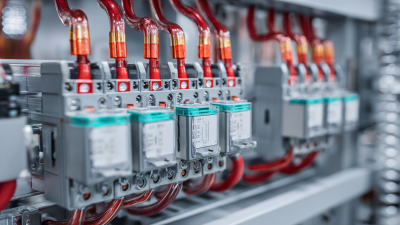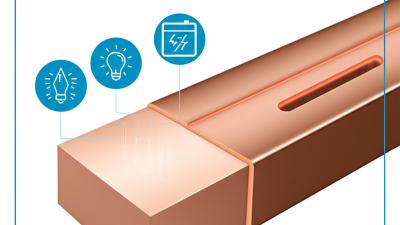How to Choose the Right Nomex Paper for Your Business Needs in China
Table of Contents
- Understanding the Different Types of Nomex Paper Available in China
- Key Factors to Consider When Selecting Nomex Paper for Your Business
- Comparing Performance Characteristics of Nomex Paper Grades
- Sourcing Nomex Paper: Where to Find Reliable Suppliers in China
- Cost-Effective Strategies for Purchasing Nomex Paper for Industrial Use
- Best Practices for Storing and Handling Nomex Paper to Maintain Quality
- Enhancing Electrical Efficiency: Insights from Recent Reports on China High-Quality Laminated Bus Bar Trends and Innovations
- FAQS
- Conclusion
- Related Posts
In today’s really competitive world, choosing the right materials for electrical insulation isn’t just a detail — it’s a key part of making sure your operations run smoothly and your products stay reliable. Among all these options, Nomex Paper definitely stands out, thanks to its excellent heat resistance and dielectric properties. It’s pretty much a go-to for electrical connection parts. If you’re wondering how to pick the best Nomex Paper for your business in China — where demand for high-quality insulating materials is definitely growing — don’t worry, we’ve got your back. As a trusted manufacturer and supplier, Sichuan D&F Electric Co., Ltd. has been committed to providing top-notch electrical insulation parts since way back in 2005. With all our experience and know-how in Nomex Paper and other electrical components, we’re here to help you navigate the tricky process of sourcing the right Nomex Paper in China to meet your goals.

Understanding the Different Types of Nomex Paper Available in China
When you're choosing Nomex paper for your business in China, it’s pretty important to get a good understanding of the different options out there. Nomex paper is well-known for its awesome thermal, electrical, and mechanical properties, which is why it’s so popular in industries like automotive, aerospace, and electronics. Now, the main types you’ll come across are Nomex 410, Nomex 420, and Nomex 440—each one built for different kinds of applications. For example, Nomex 410 is pretty versatile and strikes a good balance between thickness and heat resistance, making it a solid choice for general insulation needs.
On the other hand, Nomex 420 offers extra strength and durability, so it’s especially handy when you’re dealing with electrical insulation in tougher environments. It keeps its mechanical properties even when things get pretty extreme. And then there’s Nomex 440, which is designed specifically for really high-temperature scenarios and offers better dimensional stability. Knowing these differences is actually pretty helpful—it’ll guide you in picking the right type of Nomex paper that matches your operational needs and helps you stay competitive in the bustling Chinese market.
Key Factors to Consider When Selecting Nomex Paper for Your Business
So, if you're in China and looking to pick the right Nomex paper for your project, there's a few key things you should keep in mind. First off, you wanna pay attention to its thermal performance. According to some reports, like from ResearchAndMarkets, Nomex paper can handle temperatures up to about 220°C. That’s pretty impressive, especially if you're working with electric motors or transformers where heat resistance really matters.
Another thing not to overlook is its insulation capability. Nomex is known for having fantastic dielectric strength—usually around 18 to 20 kV per millimeter—which basically means it's great at preventing electrical failures. This is a big plus if you’re in high-voltage industries like automotive or aerospace, where dependable insulation is a must. So, when you're choosing your Nomex, make sure it ticks those performance boxes—it’ll give you peace of mind and keep things safe.
And on top of all that, thinking about the environment is becoming more and more important. The market in China, like everywhere else, is shifting towards eco-friendly options. Picking a Nomex paper that aligns with your sustainability goals not only boosts your brand’s reputation but also helps you stay within regulations. It’s kind of a win-win situation, really.
Comparing Performance Characteristics of Nomex Paper Grades
When you're trying to pick the right Nomex paper for your business, it’s really important to get a good handle on the different grades and what they can do. Nomex paper is known for its top-notch thermal and electrical insulation, but not all grades are created equal. Each one is designed for specific uses. For example, Grade 410 is super strong and often chosen when you need something that can handle high tensile stress. It’s perfect for tough environments like motors and transformers where things get hot and mechanical stress is common.

Sourcing Nomex Paper: Where to Find Reliable Suppliers in China
So, if you're on the hunt for Nomex paper in China, the biggest thing is finding reliable suppliers—trust me, that’s key to getting good quality and stuff that’s consistent. A good starting point is to do some research on manufacturers who really know this material inside out. Look for vendors with solid track records and reviews that speak for themselves. You can check out online platforms like Alibaba or Made-in-China; they’re pretty handy for spotting potential suppliers. Just make sure you dig a little deeper—background checks are your friend here.
Here’s a tip: try to attend industry trade shows and expos in China if you can. Meeting suppliers face-to-face can give you a real feel for their capabilities—and it’s a great way to build trust. Building personal relationships actually matters a lot in Chinese business culture, so don’t rush that part.
And oh—before placing a big order, ask for samples first. That way, you can see the quality of the Nomex paper up close and personal. Don’t be shy about inquiring about how they produce their paper and what kind of quality controls they have going on—knowing this stuff can really boost your confidence in their products.
Another thing that helps: tap into local contacts or trade groups. They often have the scoop on reputable suppliers, maybe through firsthand experiences. Sometimes, those personal recommendations are the best way to find trustworthy vendors in the market.
Cost-Effective Strategies for Purchasing Nomex Paper for Industrial Use
When you're looking to buy Nomex paper for industrial purposes, especially in China, cost is a big deal. A smart move? Building good relationships with trustworthy suppliers who really know your industry’s needs. Working directly with manufacturers or distributors who specialize in Nomex paper can help you snag better prices and even get discounts if you're buying in bulk. Plus, sticking with long-term partners usually means more reliable supplies and lower costs in the long run.
Another thing to keep in mind is doing your homework—compare prices, check out the quality offered by different providers, and don’t just go with the first option you find. Reading customer reviews and asking for recommendations can point you toward reputable sources that offer a good balance of price and quality. And, if possible, try sourcing Nomex paper locally. That can cut down on shipping costs and speed up delivery, making your entire procurement process more smooth and budget-friendly. Following these tips can help your business cut expenses while still getting the materials you need to keep things running smoothly.
Best Practices for Storing and Handling Nomex Paper to Maintain Quality
When it comes to storing Nomex paper, keeping its quality intact is super important if you want it to perform well in all sorts of applications. First off, you really want to stash it somewhere with the right conditions—think cool, dry, and nicely ventilated, away from humidity and crazy temperature swings. A good idea is to use moisture-proof covers or containers—that way, you’re doing a solid job protecting it from elements that might mess with its insulating properties.

Handling the stuff with care is just as crucial if you’re hoping it sticks around longer. When you’re moving or dealing with the paper, try not to bend or fold it—that can cause creases or damage that might weaken it down the line. Wearing clean gloves helps too—it keeps oils and dirt from sneaking onto the paper from your hands. And honestly, labeling your storage containers clearly makes life way easier—so you don’t have to mess around with unnecessary handling and always know where your Nomex paper is supposed to be. Following these simple tips can really make a difference, helping your Nomex last longer and work better for what you need.
Enhancing Electrical Efficiency: Insights from Recent Reports on China High-Quality Laminated Bus Bar Trends and Innovations
The recent trends in high-quality laminated bus bars in China reflect a significant advancement in electrical efficiency, which is crucial for modern power distribution systems. Laminated bus bars—also known as composite bus bars or low inductance bus bars—are engineered components designed to minimize energy loss and enhance the performance of electrical circuits. By integrating fabricated copper conductive layers with thin dielectric materials, these components achieve a unified structure that effectively reduces inductance.
Innovation in the design of laminated bus bars is leading to more compact and efficient power solutions. The separation of conductive layers by dielectric materials not only decreases electromagnetic interference but also helps in managing thermal properties more effectively. This is essential for ensuring the reliability and longevity of electrical systems, particularly in applications that demand high performance and energy efficiency. As industries continue to push the boundaries of technology, the role of high-quality laminated bus bars becomes increasingly vital, promising to enhance the overall effectiveness of electrical infrastructures.
Moreover, the adoption of laminated bus bars is gaining momentum worldwide, as they provide significant advantages over traditional bus bar systems. This trend is a response to the growing demand for energy-efficient solutions, driven by increasing electricity consumption and environmental concerns. The innovation in laminated bus bar manufacturing is thus not merely a technical improvement but a necessary step towards sustainable energy management in the global market.
FAQS
: The primary types of Nomex paper include Nomex 410, Nomex 420, and Nomex 440, each designed for specific applications.
Nomex 410 is a versatile choice with a balance between thickness and temperature resistance, making it suitable for general insulation applications.
Nomex 420 provides additional strength and durability, making it especially beneficial for electrical insulation in demanding environments.
Nomex 440 is designed for applications that require high temperature resistance and enhanced dimensional stability.
Businesses should understand the performance characteristics of each grade and choose one that aligns with their operational requirements for optimal performance and longevity.
Store Nomex paper in a controlled environment, away from humidity and temperature fluctuations, ideally in a cool, dry, and well-ventilated area.
Handle Nomex paper with care, avoid bending or folding, use clean gloves to prevent contamination, and clearly label storage containers to avoid unnecessary handling.
Protecting Nomex paper from moisture is crucial because moisture absorption can compromise its insulating properties.
Understanding the unique properties helps businesses make informed decisions, enhancing product reliability and operational efficiency in demanding environments.
Conclusion
In today's industrial world, picking the right Nomex Paper in China can really make a difference when it comes to performance and safety. This post will walk you through the different types of Nomex Paper out there, highlighting key things like thickness, how well it handles high temperatures, and what specific uses you might need it for. We’ll compare various grades so you can get a clear idea of their strengths and weaknesses, helping you make smarter decisions based on what your operations actually need.
On top of that, finding reliable suppliers in China is super important if you want good quality materials without breaking the bank. Companies should look into cost-effective ways to buy Nomex Paper, but don’t forget—storing and handling it properly is just as crucial to keep it in top shape and make sure it lasts. Once you get a grasp on these details, you can really leverage Nomex Paper from China to boost your business operations and handle your electrical insulation needs more confidently.
Related Posts
-

The Ultimate Checklist to Choosing the Best Copper Bus Bar for Global Procurement
-

Mastering Gpo3 Material with These Essential Digital Strategies
-

How to Choose the Right Flexible Busbar Solutions for Your Industrial Needs
-

How to Achieve Maximum Energy Efficiency with H Class Insulation Solutions
-

Unlocking the Advantages of Bare Copper Strip in Electrical Applications for Energy Efficiency
-

5 Key Insights on Winding Insulation Class for Optimal Motor Performance










